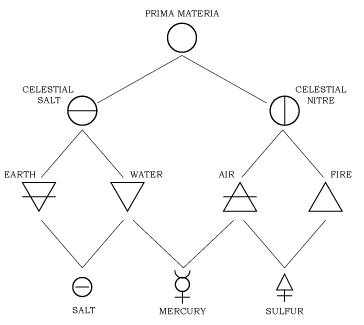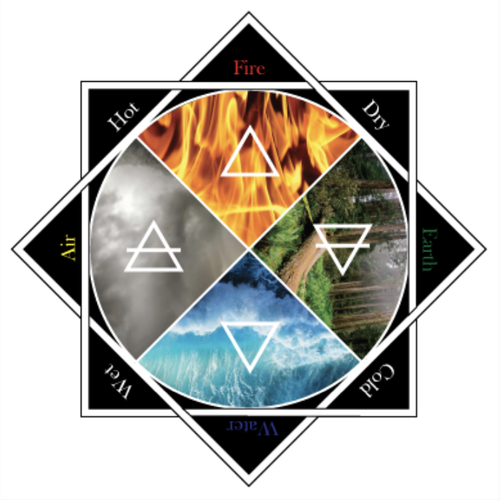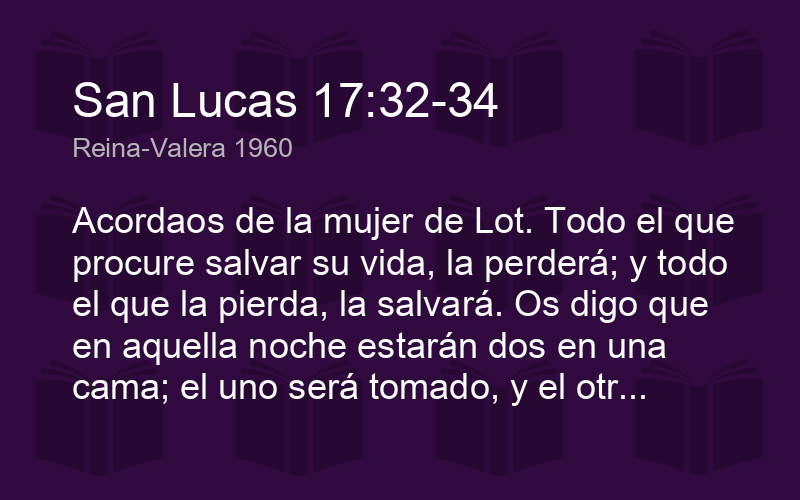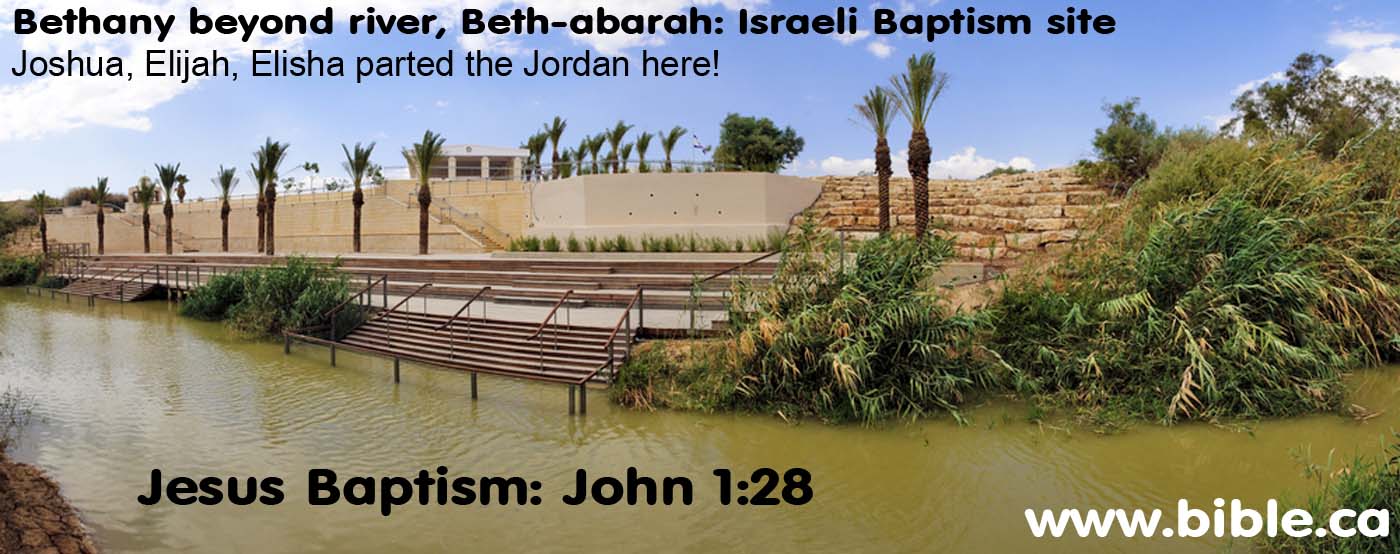|
|

salt lake city=alchemy (salt)=dollar=$= LOT S WIFE (SODOMA AND GOMORRA)
Cathedral of the Madeleine
From Wikipedia, the free encyclopedia
The Cathedral of the Madeleine is a Roman Catholic church in Salt Lake City, Utah, United States. It was completed in 1909 and currently serves as the cathedral, or mother church, of the Diocese of Salt Lake City. It is the only cathedral in the U.S. under the patronage of St. Mary Magdalene.
Description[edit]
The cathedral was built under the direction of Lawrence Scanlan, the first bishop of Salt Lake City, who dedicated it to St. Mary Magdalene.[2] It was designed by architects Carl M. Neuhausen and Bernard O. Mecklenburg. The exterior is predominantly a Neo-Romanesque design, while the inside displays more Neo-Gothic details. Construction began in 1900 and was completed in 1909. It was dedicated by James Cardinal Gibbons, Archbishop of Baltimore.
It is theorized that Bishop Scanlan chose Mary Magdalene as the patron saint of the Diocese of Salt Lake because her feast day is on July 22, two days before Pioneer Day, a celebration commemorating the arrival of the Mormon pioneers in Salt Lake Valley, so that Catholics would have something to celebrate alongside the region's dominant faith.[3]
The interior of the cathedral was created under the direction of Joseph S. Glass, the second bishop of Salt Lake. Bishop Glass enlisted John Theodore Comes, one of the preeminent architects in the country, to decorate the interior of the cathedral. His plans for the interior were largely based upon the Spanish Gothic style. The colorful murals and polychrome were added at this time, as were the ornate shrines. In 1916, Bishop Glass also changed the name of the cathedral to the French spelling after visiting her purported tomb.[2]
In the 1970s, the exterior of the building was restored, and between 1991 and 1993, the interior of the cathedral was renovated and restored under Bishop William K. Weigand. This included not only the removal of dust and dirt and restoration of the interior but also changes to the liturgical elements of the cathedral to bring them into conformity with certain widespread changes in liturgical practice that developed after the Second Vatican Council.
This included constructing a new altar, moving the cathedra, creating a separate chapel for the Blessed Sacrament, and adding an ample baptismal font. The Blessed Sacrament Chapel also contains the tomb of Bishop Scanlan.[4] Resting atop the tomb is a case containing a small relic of Saint Mary Magdalene. The cathedral in Salt Lake City and the Basilica of Saint-Maximin-la-Sainte-Baume in France are the only cathedrals in the world holding first-class relics of the saint and are named in her honor.[5] The major restoration of the interior of the cathedral was accomplished through the vision of Monsignor M. Francis Mannion.[6]
The cathedral is home to the only co-educational Catholic Choir School in the United States. The Madeleine Choir School, established in 1996, now serves over 400 students in Pre-Kindergarten through Grade Eight.[7] The Cathedral Choir has recorded several CDs and routinely tours both nationally and internationally. In addition to singing daily services at the Cathedral of the Madeleine, choristers have sung at St. Peter's Basilica (Vatican City), Notre Dame de Paris (France), and in churches across the United States of America, Spain, Italy, France, Belgium, and Germany, among other places.[8]
Composer Amédée Tremblay notably served as the church's organist from 1920 to 1925.[9]
-
-
Cathedral of the Madeleine, looking east
-
Interior of the cathedral
-
   |
|
|
|
|
ALCHEMY : AL-KHEMIA : ????????????????
Alchemy unraveled from all its mystery and mysticism is simply the practical application of Nature and Natural processes. Whether pertaining to metals, plants, or spirituality, alchemists strive towards the same goal of transmuting a raw and impure material into its elevated and purified form through the replication of the same natural processes that form our Universe. Regardless of the details of the practice - allegorical, spiritual or physical - the philosophy and core methodology remain the same.
Alchemy is to be understood and approached as both work and ritual. It is the very definition of a Sacred Science as captured by the etymological roots of where it is practiced; the laboratory - as an amalgamation of labor and oratory.
The word Alchemy (and consequently, chemistry) reaches our English language from the Greek χημεία (khemia, "cast together" or "pour together"). It is further derived from the Greek rendering of the Egyptian word kemet ( Km.t , ????????????????) one of the ancient names of Egypt meaning “land of black earth” from where the practice is believed to have originated. The Al - prefix of course coming from the Arabic definite article “the”. Thus, Alchemy came to also be known as a Hermetic Science intimately tied to the Hermetic philosophy of Hellenized Egypt, as well as the “Black Art” and the “Royal Art” in reference to both the land of Egypt and the spiritual powers of transmutation and life-after-death imparted to the Pharaohs as Divine Kings.
ALCHEMICAL POLARITIES, ELEMENTS & PRINCIPLES
Alchemical theory describes the universe as being composed of 2 Polarities (Celestial Salt, Celestial Niter), 4 Elements (Fire, Water, Air, Earth), and 3 Principles (Sulfur, Salt, Mercury). This is the mean by which the Cosmos comes into existence, Order arises out of Chaos, and the One is made manifest into the many.
Celestial Niter and Celestial Salt are the polarities of Creation. These are respectively the Active, Volatile and Expansive energy of the Divine Masculine aspect of the Cosmos (Celestial Niter) and the Passive, Fixed and Contractive energy of the Divine Feminine (Celestial Salt). From this polarity all is set in motion and the inherent tension between the Spiritual and the Material is born.
The 4 elements of Fire (????), Water (????) , Air (????) and Earth (????) are further expressions of the Volatile (Fire & Air) and Fixed (Earth & Water) Celestial polarities. Today we refer to them as the "classical" Elements to differentiate them from the elements of the periodic table; and since they made their way into Western culture via the writings of classical Greek philosophers. However, the concept of four elements predates the ancient Greeks by millennia. The first written evidence of a cosmology centered around four Elements is found in the Babylonian epic Enûma Eliš dating to the 18th/19th Century B.C.E.
The classical elements represent the Elemental forces of Nature. So while in a alchemical or magical sense we may call upon Fire per say, we are not just invoking the fire made of burning embers and flame we commonly associate with the word "fire"; rather we are invoking capital “F” Fire, the philosophic active and expansive Element of creation of which the fire of flame is but a manifestation.
Aristotle in his work On Generation and Corruption went on to describe the Elements in terms of four sensible qualities: Hot, Cold, Wet, and Dry. Each of the classical elements contains two qualities, a primary and a secondary. Fire is primarily Hot and secondarily Dry, Water is primarily Cold and secondarily Wet, Air is Hot and Wet, and Earth is Cold and Dry. As such, nearly every substance on earth could be described as pertaining to one of the classical elements given how that substance is perceived by our senses.
The Three Alchemical Principles of Mercury (☿), Sulfur (????), and Salt (⊖), pertain to all members of the Mineral, Animal and Plant kingdoms . As with the Alchemical Elements, these three essential Principles do not equate with the chemical elements or compounds we associate with these words but with the philosophic principles expressed in the Natural and Spiritual worlds. These are respectively the Spirit, Soul and Body of a thing.
Alchemical Mercury is the Spirit, that vital life force that flows through all beings of the same kingdom and species. There is a Human spirit and life force as there is one for minerals, plants and animals. It is the fluidic principle that connects and runs through all members of the Natural world as a current of visceral, instinctual and psychic streams. It predominates in the elements of Water and Air.
Alchemical Sulfur is Soul. It constitutes the volatile principles of Fire and Air and is the expression of consciousness, divine intellect and the true Will of an individual. It is that principle given straight from God that makes each of us individually unique and is the root of our own consciousness and Higher Self. While we share the Human Spirit, each of us has a more individual expression of Soul that applies to us while living as the means by which we can retain a sense of Self in the vast ocean of Spirit and by which we can irrefutably state that “I am”.
Alchemical Salt is the Body - the fixed and material principle found in the elements of Earth and Water in which both the Spirit and Soul can coexist and act. It is only through Body that the union of Spirit & Soul can occur and be expressed via the experience of life.The Philosopher’s Stone of Spiritual Alchemy is the creation of a new immortal body of light that persists after death and retains the Sulfuric and Mercurial principles so that our Sense of Self (Spirit + Soul) instead of being dissolved into the streams of Sprit and reabsorbed back into the divine source of Soul can continue to coexist and experience eternal life after death.
| | Glyph | Alchemical Property |
| Celestial Nitre |
???? |
Active, Volatile and Expansive energy of Creation. Force of Spirit. |
| Celestial Salt |
???? |
Passive, Fixed and Contractive energy of Creation. Force of Matter. |
| Fire |
???? |
Active & expansive Element. The agent of heat & dryness in Nature. Consciousness within man and the ability to project Will.
|
| Water |
???? |
Passive & fluidic Element. The cold & moist aspect of Nature. Intuition and the subconscious “current” within man and the ability to receive input.
|
| Air |
???? |
Mediating & vaporous Element. The hot & moist aspect of Nature. Breath, thought and life within man and the ability to communicate.
|
| Earth |
???? |
Solidifying & most dense Element. The cold & dry aspect of Nature. Physicality in man and the ability to perceive through the senses. |
| Salt |
⊖ |
Body. The material principle in which both the Spirit and Soul can coexist and act. Predominates in the Fixed elements of Earth and Water. |
| Mercury |
☿ |
Spirit. The vital life force that flows through Nature as a current of visceral, instinctual and psychic streams. Predominates in Air & Water. |
| Sulfur |
???? |
Soul. The expression of consciousness, divine intellect and the true Will of an individual. Predominates in the Volatile elements of Fire & Air |
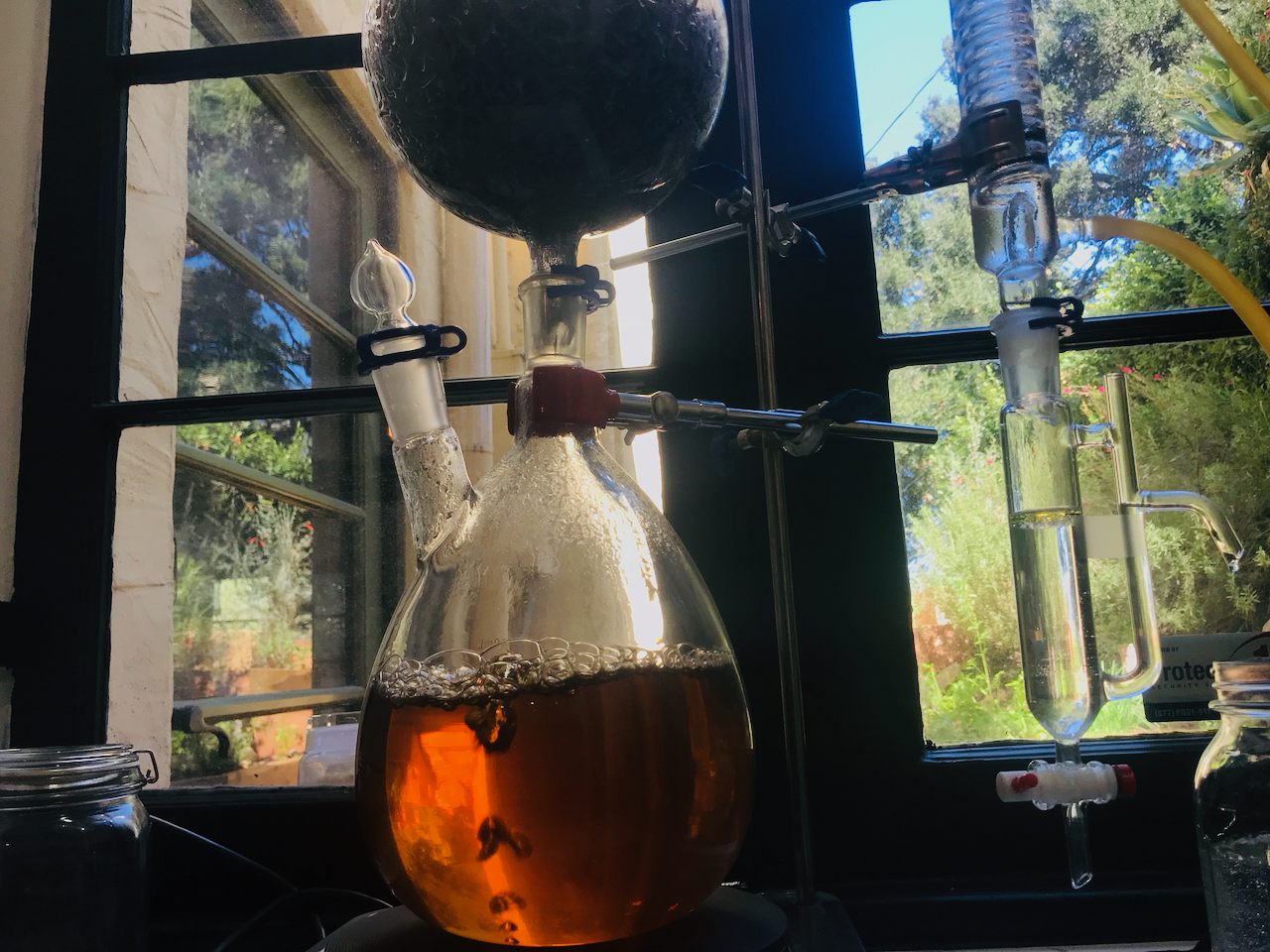
SPAGYRICS
Paracelsus coined the term Spagyric to describe an alchemical process that contrary to popular belief is not exclusive to plants. Derived from Ancient Greek σπάω (spao, "to draw out”) and ἀγείρω (ageiro ,”to gather”), Spagyric literally means to extract and recombine. It describes the process at the heart of the alchemical axiom - Solve et Coagula, whereby from a base material (whether of vegetable, animal or mineral kingdom) we extract the three Philosophic Alchemical Principles of Salt, Mercury and Sulfur. We in turn refine and recombine this triad of Body, Spirit and Soul into an elevated form as a Spagyric preparation. Spagyric preparations are EXTREMELY potent medicines, where a regular tincture may require 20-50 drops to be effective, a Spagyric preparation would only require 1 or 2 drops to have the same effect.
The Spagyric processs is a microcosmic representation of the natural cycles of our planet. A Fire element heats Water which in turn vaporizes into the Air and interacts with an Earthen element (the prima materia) prior to cooling and returning to liquid. Wet organic matter putrefies and ferments into alcohol, it then dries and succumbs to the inner heat of decomposition transforming itself into ash, salts and dirt. Nothing here is artificial, it’s all natural processes sped up through the manipulation of hot and cold elements.
Every part of the process is to be meditated upon and contemplated. Alchemy is a sacred spiritual pursuit that puts us in touch with something far greater than ourselves.
SPAGYRICS: THE ALCHEMICAL PRINCIPLES OF PLANTS
As discussed above, all members of the Plant, Animal and Mineral kingdoms are understood by Alchemists to be endowed with the Three Philosophic Principles of Mercury/Spirt , Sulfur/Soul and Salt/Body.
Mercury/Spirit of the Plant - This is Ethanol, plant alcohol. Every plant regardless of species when left in water “dies” and putrefies thereby fermenting the water and creating alcohol. All plants produce the exact same type of alcohol - Ethanol. This is the universal spirit of plants…it is something that is so clearly in our daily vocabulary that we often overlook it. Ever wonder why alcohols are called spirits?
Sulfur/Soul of the Plant - The Essential Oil. This is what makes the plant unique, what gives it a distinct flavor or aroma or medicinal or spiritual property. You need not see the plant to know from what plant the essential oil comes. For example, take a whiff of a Rosemary oil, immediately you can identify what it is as this is the individual expression of that plant. The Essential Oil contains most of the healing and magical properties of the plant.
Salt/Body of the Plant - This is the vessel in which the Soul and Spirit are contained during the lifespan of the plant. The leaves, the bark, the wood, the roots, the ash, etc…
SPAGYRICS: PLANT MEDICINE PREPARATION
???? Extraction of the Sulfur
This is the first step of a simple Spagyric preparation. When dealing with plants, the Sulfur is the Essential Oil, this is the volatile principle that expresses the individual Soul of the plant. We extract the Sulfur of the plant via steam distillation whereby the plant is steamed with distilled water that transmutes the volatile essential oils into vapor which is then cooled back into liquid through the condenser tubes. We collect and bottle the essential oil (Sulfur of the plant), and set aside the remaining distillation water and hydrosol.
☿ Fermentation & Distillation of the Mercury
This is the death and putrefaction of the plant material. Our objective is to release the plant Spirit from the body of the plant in the form of Ethanol Alcohol. First, we remove the plant material from the distillation biomass vessel and place it in a fermentation jar together with the Hydrosol water and the remaining distillation water. We then add a handful of fresh plant material in order to introduce natural yeasts into the fermentation process and then set the jar aside in the cellar.
Over the course of several weeks, the decomposing plant matter releases CO2 as it ferments in the water. Once the rate of CO2 release slows down and eventually stops, the fermentation process is complete. At this point we have the fermented solution of water and ethanol which we need to further distill to separate the Mercury (alcohol) from the water. We repeat this distillation process 7 times, each distillation producing a more refined Alcohol and thus, purer Spirit. We bottle and label the Alcohol as the Mercury of the plant and set aside the remaining water (known as the Phlegm).
⊖ Calcination of the Salt
Through repeated incineration and grinding down in a mortar and pestle, we are able to refine the remaining plant matter into a whiteish/grayish fine chalk-like ash. Once we achieved the desired purity of the ash salt (as close to white as possible) we combine the ash with the Phlegm and any remaining hydrosol in roughly 1:3 ratio, stir and let sit for 24 hours. The rehydrated ash produce salt crystals which herald the final stage of the calcination phase.
☌ Recombination
Lastly, we recombine and bottle the extracted Sulfur (Essential oils), Mercury (Alcohol), and Salt (Mineral Crystals) of the plant into its final medicine.
SPAGYRICS: AS ABOVE, SO BELOW
To ensure the most refined and potent medicine, we astrologically time the Spagyric operations to align in accordance with the biological and spiritual rhythms of Nature and our Cosmos. The Hermetic axiom of “as above, so below” guides our work; for everything on earth is forever connected to the Cosmos from which all came into being. The principles that govern the celestial bodies in the sky above our heads are the same as those that are affecting the roots of plants in the soil below. Thus plants are harvested and medicines prepared on the appropriate Planetary days and hours (see below) according to the correspondences of the plant and the desired effect of the medicine, and always in strict observation of the Moon and her cycles. Those medicines designed to take things away (Pain relief, reduce inflammation, etc.) should be timed to have the major stages (extraction, fermentation/distillation, calcination, recombination, etc.) on the Full Moon so that it orients to the diminishing moonlight imbuing the medicine with that power of reduction. Alternatively a medicine created to bring something in (Improve immunity, give energy, etc.) should be time to align with the New Moon and be prepared during the growing light. Medicines designed for more esoteric pursuits (spirit sight, dream work, etc) will often require a combination of lunar cycles, major solar events (i.e. solstices & equinoxes), and other planetary alignments to reach their full potential.
https://via-serpentis.com/alchemia |
|
|
|
|
Jordan River (Utah)
From Wikipedia, the free encyclopedia
The Jordan River, in the state of Utah, United States, is a river about 51 miles (82 km) long. Regulated by pumps at its headwaters at Utah Lake, it flows northward through the Salt Lake Valley and empties into the Great Salt Lake. Four of Utah's six largest cities border the river: Salt Lake City, West Valley City, West Jordan, and Sandy. More than a million people live in the Jordan Subbasin, part of the Jordan River watershed that lies within Salt Lake and Utah counties. During the Pleistocene, the area was part of Lake Bonneville.
Members of the Desert Archaic Culture were the earliest known inhabitants of the region; an archaeological site found along the river dates back 3,000 years. Mormon pioneers led by Brigham Young were the first European American settlers, arriving in July 1847 and establishing farms and settlements along the river and its tributaries. The growing population, needing water for drinking, irrigation, and industrial use in an arid climate, dug ditches and canals, built dams, and installed pumps to create a highly regulated river.
Although the Jordan was originally a cold-water fishery with 13 native species, including Bonneville cutthroat trout, it has become a warm-water fishery where the common carp is most abundant. It was heavily polluted for many years by raw sewage, agricultural runoff, and mining wastes. In the 1960s, sewage treatment removed many pollutants. In the 21st century, pollution is further limited by the Clean Water Act, and, in some cases, the Superfund program. Once the home of bighorn sheep and beaver, the contemporary river is frequented by raccoons, red foxes, and domestic pets. It is an important avian resource, as are the Great Salt Lake and Utah Lake, visited by more than 200 bird species.
Big Cottonwood, Little Cottonwood, Red Butte, Mill, Parley's, and City creeks, as well as smaller streams like Willow Creek at Draper, Utah, flow through the sub-basin. The Jordan River Parkway along the river includes natural areas, botanical gardens, golf courses, and a 40-mile (64 km) bicycle and pedestrian trail, completed in 2017.[6]
The Jordan River is Utah Lake's only outflow. It originates at the northern end of the lake between the cities of Lehi and Saratoga Springs. It then meanders north through the north end of Utah Valley for approximately 8 miles (13 km) until it passes through a gorge in the Traverse Mountains, known as the Jordan Narrows. The Utah National Guard base at Camp Williams lies on the western side of the river through much of the Jordan Narrows.[7][8] The Turner Dam, located 41.8 miles (67.3 km) from the river's mouth (or at river mile 41.8) and within the boundaries of the Jordan Narrows, is the first of two dams of the Jordan River. Turner Dam diverts the water to the right or easterly into the East Jordan Canal and to the left or westerly toward the Utah and Salt Lake Canal. Two pumping stations situated next to Turner Dam divert water to the west into the Provo Reservoir Canal, Utah Lake Distribution Canal, and Jacob-Welby Canal. The Provo Reservoir Canal runs north through Salt Lake County, Jacob-Welby runs south through Utah County. The Utah Lake Distribution Canal runs both north and south, eventually leading back into Utah Lake.[9] Outside the narrows, the river reaches the second dam, known as Joint Dam, which is 39.9 miles (64.2 km) from the river's mouth. Joint Dam diverts water to the east for the Jordan and Salt Lake City Canal and to the west for the South Jordan Canal.[10][11][12]
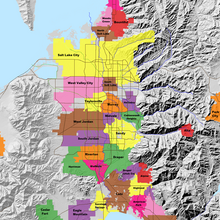
Map of the Salt Lake Valley
The river then flows through the middle of the Salt Lake Valley, initially moving through the city of Bluffdale and then forming the border between the cities of Riverton and Draper.[7] The river then enters the city of South Jordan where it merges with Midas Creek from the west. Upon leaving South Jordan, the river forms the border between the cities of West Jordan on the west and Sandy and Midvale on the east. From the west, Bingham Creek enters West Jordan. Dry Creek, an eastern tributary, combines with the main river in Sandy. The river then forms the border between the cities of Taylorsville and West Valley City on the west and Murray and South Salt Lake on the east. The river flows underneath Interstate 215 in Murray. Little and Big Cottonwood Creeks enter from the east in Murray, 21.7 miles (34.9 km) and 20.6 miles (33.2 km) from the mouth respectively. Mill Creek enters on the east in South Salt Lake, 17.3 miles (27.8 km) from the mouth. The river runs through the middle of Salt Lake City, where the river travels underneath Interstate 80 a mile west of downtown Salt Lake City and again underneath Interstate 215 in the northern portion of Salt Lake City. Interstate 15 parallels the river's eastern flank throughout Salt Lake County. At 16 miles (26 km) from the mouth, the river enters the Surplus Canal channel. The Jordan River physically diverts from the Surplus Canal through four gates and heads north with the Surplus Canal heading northwest. Parley's, Emigration, and Red Butte Creeks converge from the east through an underground pipe, 14.2 miles (22.9 km) from the mouth.[7] City Creek also enters via an underground pipe, 11.5 miles (18.5 km) from the river's mouth. The length of the river and the elevation of its mouth varies year to year depending on the fluctuations of the Great Salt Lake caused by weather conditions. The lake has an average elevation of 4,200 feet (1,300 m) which can deviate by 10 feet (3.0 m).[3] The Jordan River then continues for 9 to 12 miles (14 to 19 km) with Salt Lake County on the west and North Salt Lake and Davis County on the east until it empties into the Great Salt Lake.[7][8][11]
Discharge[edit]
The United States Geological Survey maintains a stream gauge in Salt Lake City that shows annual runoff from the period 1980–2003 is just over 150,000 acre-feet (190,000,000 m3) per year or 100 percent of the total 800,000 acre-feet (990,000,000 m3) of water entering the Jordan River from all sources. The Surplus Canal carries almost 60 percent of the water into the Great Salt Lake, with various irrigation canals responsible for the rest. The amount of water entering the Jordan River from Utah Lake is just over 400,000 acre-feet (490,000,000 m3) per year. Inflow from the 11 largest streams feeding the Jordan River, sewage treatment plants, and groundwater each account for approximately 15 percent of water entering the river.[13]
Watershed[edit]
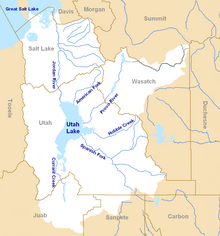
Map of the entire Jordan River Basin
|
|
|
 Primer Primer
 Anterior
3 a 17 de 122
Siguiente Anterior
3 a 17 de 122
Siguiente Último
Último
|
